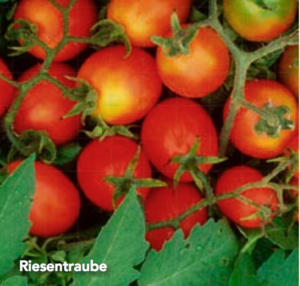This year’s Burke’s Backyard Winter Tomato seeds include the popular Giant Tree Tomato and three other cool-season varieties for you to try.
There are around 50 seeds per pack, so sow these and you are bound to get plenty of tomatoes to enjoy through the cooler months. The seeds in the pack are colour-coded with a harmless dye according to the tomato variety.
Blue: ‘Giant Tree Tomato’, a tall variety up to 3m high, definitely needs staking, produces huge fruit up to 500g and larger. Fruits in around 90 days.
Red: ‘Riesentraube’, which means ‘giant bunch of grapes’. This is a compact grower with good foliage cover. Very productive, hundreds of blooms develop into clusters of 20-40 small fruit (3-3.5cm round). Flavour is a classic beefsteak tomato. The vine is compact to 1.2m x 60cm but some support for the fruiting branches is a good idea. Fruits in around 75 days.
Green: ‘Oregon Spring’, developed by Oregon State University USA for its cold-tolerance and short growing season. It’s a compact plant which produces medium to large almost seedless, juicy fruit.
Purple: ‘Black Cherry’, abundant round cherry tomatoes with a classic black tomato flavour – sweet and rich. A tall, vigorous grower, it needs staking. Ripens in around 65 days.
Getting started
- You can sow seeds directly into the prepared garden bed, or into small pots of seed-raising mix.
- Cover seeds with a light sprinkling of seed-raising mix.
- Water in gently with a sprayer.
- Keep warm and moist to germinate (usually within seven to 14 days, but sometimes it can take longer. You can transplant seedlings to a larger pot filled with potting mix when they have their first set of adult leaves (which are distinctly different from the first set of leaves).
- Plant in garden or very large pot when 10-15cm tall. Space seedlings 60cm apart for smaller growers and up to 1m for the Giant Tree Tomatoes. Provide a stake for tall varieties at planting time.
- Water in with a seaweed solution (eg, Seasol) to help plants establish, then keep plants evenly moist. Mulch with lucerne hay or pea straw. Feed plants monthly with tomato food or pelletised chicken manure (eg, Dynamic Lifter).
Your seeds have been packed in Australia by Royston Petrie Seeds Pty Ltd, phone 1300 307 338. They’re certified for distribution in Tas, WA and NZ (Lot no. WT11).
LAST YEAR….
Here’s some feedback from people who tried our Winter Tomato seeds last year:
Well, it will come as no surprise to tell you that readers in warmer climates such as Qld and the NSW coast had great success, but the terrific news is that some gardeners in much cooler-winter parts of Australia, such as Melbourne, Mt Gambier in SA, South-Western WA and Glen Innes and Tamworth on the NSW Northern Tablelands also had their successes. Here are a few lessons which we’ve gleaned from all your fabulous feedback and reports.
- Find a ‘warm zone’
The trick in the cooler spots was to grow the winter tomatoes in a warm ‘micro-climate’. For example, Col and Beryl Parry in chilly Glenn Innes grew their tomatoes in pots on a sunny verandah. The pots sat on the sun-warmed concrete, and the plants grew up the sun-warmed brick wall of their house.
- Use pots in cool spots
In Melbourne, gardeners such as Shirley D’Alterio of Morwell, also grew her tomatoes in pots and said all four tomato varieties did well for her. The pots have to be a decent size for the size of the tomato plant (eg, 30cm diameter minimum), but they allow you to move the plant into the sunniest spots, and also to protect plants more easily from bad weather, such as frosts and storms.
- Use hot houses
Carmel Millard, of Mt Gambier in SA, sent in a very detailed report on her progress in that cool-winter part of Australia. She did lose plants to frost for those grown out in the ground (Carmel says June and July were very frosty this year), but her hothouse-grown ‘Stupice’ plants in particular produced plenty of delicious, clean, fab-tasting fruit. She said that all four varieties fruited for her, and though the frosts knocked off a few plants out in the garden, she concluded “I would like to have another go next year.” Good on you, Carmel!
- Protect from frost
Many of your reports said you went well in April, May and early June, but by July the frosts clobbered quite a few plants. So, the tip is to move potted plants into protection, or use frost cloths, plastic bags or shadecloth to protect plants when chilly nights are forecast. Remember to remove the protection the next morning.
- Try the Giant Tree Tomato
Of the four varieties you tried last year, more people had more success with the Giant Tree Tomato, so it’s the one we’re doing again this year. None of last year’s other varieties were duds – we received success stories for all of them – but the Giant Tree Tomato produced enormous fruits with fabulous flavour. It’s a ripper.
- Ripening tip
Sun-ripened tomatoes taste best, but if you’re in a cool spot and the ripenening isn’t happening, Godfrey Dol, tomato-growing expert from the Tomato Exchange in Guyra, NSW, says the best way to ripen tomatoes is to put them into a paper bag along with a banana. The banana peel emits a gas called ethylene, which acts as a hormone on the tomato and speeds up ripening. To speed up winter ripening even more, place the tomato in the bag with the banana, then place the bag on a sunny windowsill indoors.



